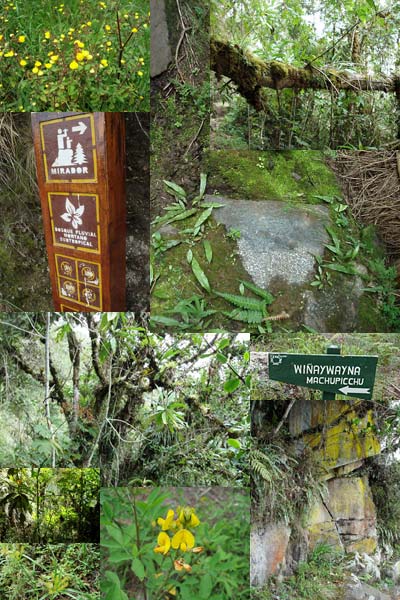
THE TREASURES OF PERU
Photos by Lawrence Davis, Publisher Splash Magazines

Peru is a country of unsolved ancient mysteries, priceless archeological treasures and a cuisine as diverse as the country itself. Divided into three regions' coastal, highlands and jungle' each region has its own character, distinct tastes, music and cultural customs. Collectively, this agricultural country is the largest grower of potatoes (83 varieties to be exact) and contains 84 of the earth's 104 ecosystems.
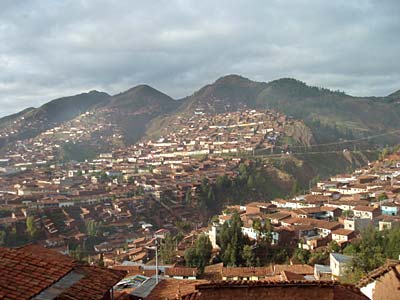
Midnight
I land in Lima on an AA flight from JFK after a change of terminals and planes
in Miami' a routing I do not recommend now that I know LAN flies non-stop from
New York. A rep from PromPeru and Alli, our guide for the week, greets and
transfers our group of four to the Sonesta El Olivar Hotel.
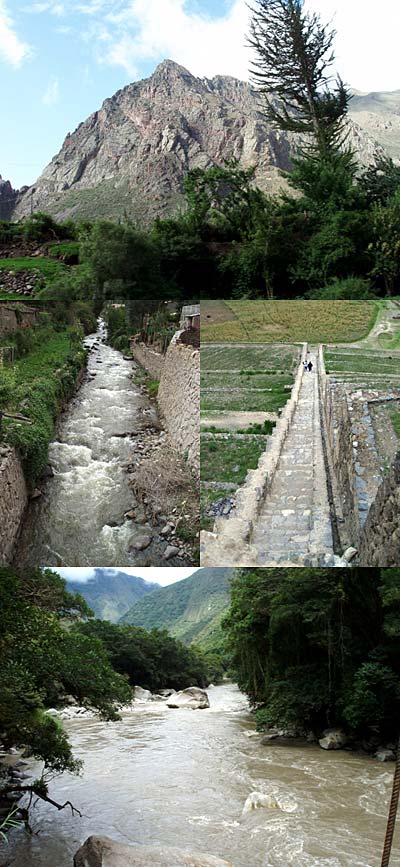
Saturday
We fly to the province of Ica in a prop plane, and then board a seven-passenger
Cessna to fly over the Nazca Lines' giant riddles that cover 300 square miles of
desert sand. From the air, the Nazca Lines, made by the Nazca Tribe, include
not only 10,000 lines and geometric shapes, but also depictions of monkeys,
birds, fish, plants' and even an astronaut. Like embroidery of the gods, the
Nazca Lines (discovered by a pilot in 1927, declared a Mankind Heritage Site by
UNESCO in 1994) remain one of the world's greatest unsolved mysteries. Our
pilot banks from side to side, using his wings to point out imprints while a 450
foot long bird catches my attention; it is eerie to see the astronaut in a
spacesuit and helmet that so much resembles today's astronauts. There are as
many theories as there are lines as to how the Nazcans crafted the drawings,
what technology they used and what purpose the lines served. Was this a
cathedral for celestial prayer or a calendar for sending messages to outer
space? Perhaps we are the creatures from outer space they were expecting?
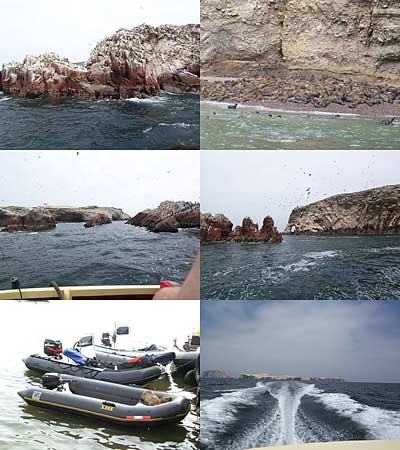
We board a launch and zip across the Pacific Ocean to Isla Ballestas, the Paracas Natural Preserve, where hundreds of bird species and 1,000 sea lions and penguins live and mate. The sea is calm, and the breeze refreshing. Erosion of the ocean has created inviting caves; we idle and drift into several, clapping and banging on the side of the boat to communicate with the sea lions that languish on rocks. A male sea lion, recognizable by hair down to his shoulders, has eight to 12 females in his harem. We pass the beach where every 11 months the females journey to give birth. A huge brown male lifts his head and proudly angles it towards our cameras as if on cue. A one-eyed cormorant gives me the evil eye; it is a scene out of Hitchcock's movie, 'The Birds' with swarms of black birds soaring and swooping in and out of the sea.
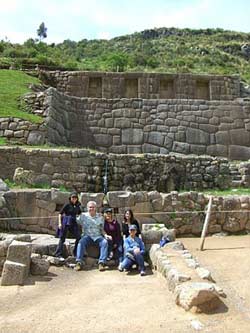
In Chinchero, a small town built over Inca ruins, we follow a steep path to an ancient Water Temple. Water was power to the Incas as they used it to expand their territories with a sophisticated irrigation system' they even built temples where they worshipped water. Only nobility, high priests and virgins of the sun were allowed to participate in the Water Temple purification ritual.
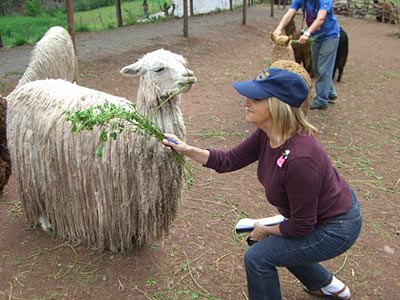

A full day in the Sacred Valley includes a visit to the Alpaca Breeding Grounds, known as the Living Museum of the Andes, where we feed llamas and alpacas (part of the camel family) stalks of alfalfa; Vicunas, considered 'the walking gold of Peru,' graze on higher slopes. We then buy clothing, made from wool that is sheared every two years at the adjoining Sol Alpaca showroom. We visit the remarkable archeological sites of Tambomachay, Ollantaytambo and Pisac where the market is bustling with vendors selling local crafts. We bargain for handmade treasures, and then sip chichi mais' beer made from corn.
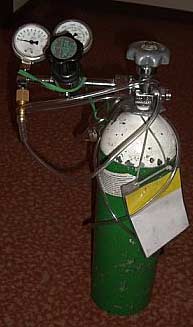 It takes a day to adjust to Cusco's high altitude. Cusco, the archeological
capital of the Americas, is one of the most extraordinary cities in the world.
Cradled by the Andes, at night the lights of the city resemble a massive altar
of glowing candles. The charming and intimate Novotel Hotel is close to Plaza
de Alma, the main square. The magnificent Cathedral with 11 chapels is a
triumph of Colonial architecture. Iglesia de Santo Domingo, the oldest church
in Cusco, was built on top of the Inca Temple of the Sun, one of their most
religious sanctuaries. The Spanish conquerors worked hard to cover and destroy
all traces of Inca life, building on top of villages and temples they
destroyed. The Cusco School of Art was founded in 1580 by an Italian artist;
other European and Inca artists became part of the movement. Today, the San
Blas section of the city is home to many fine galleries and artist studios.
It takes a day to adjust to Cusco's high altitude. Cusco, the archeological
capital of the Americas, is one of the most extraordinary cities in the world.
Cradled by the Andes, at night the lights of the city resemble a massive altar
of glowing candles. The charming and intimate Novotel Hotel is close to Plaza
de Alma, the main square. The magnificent Cathedral with 11 chapels is a
triumph of Colonial architecture. Iglesia de Santo Domingo, the oldest church
in Cusco, was built on top of the Inca Temple of the Sun, one of their most
religious sanctuaries. The Spanish conquerors worked hard to cover and destroy
all traces of Inca life, building on top of villages and temples they
destroyed. The Cusco School of Art was founded in 1580 by an Italian artist;
other European and Inca artists became part of the movement. Today, the San
Blas section of the city is home to many fine galleries and artist studios.
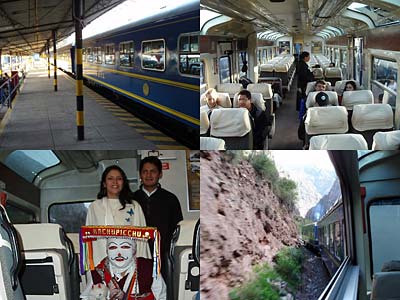
The PeruRail train ride from Cusco to Aguas Calientes and the pueblo of Machu Picchu takes three hours. The journey begins slowly as the train makes three switchbacks to climb the steep terrain. We pass people living in shacks close to the tracks; a senora washes clothes in a purple drum; a shoemaker sits mending shoes; old dogs wave their tails as we chug by; a bush of yellow flowers is in full bloom; a fat pig feeds in the mud; chickens peck away at garbage; ponies, sheep, llamas and cows graze on the fertile soil. The train's whistle fills the morning air as we wind our way slowly up the Andes. Two attendants pass out blue and gold blankets; lunch is served. About two hours into our climb, the train passes under an arch in the village of Katica, signaling that we have reached an elevation of 13,000 feet, the highest point of our climb. We descend into the Sacred Valley, crossing the Urubamba River. A young boy pushes a wheel barrel filled with vegetables; we pass houses painted blue, yellow and green. The train makes two stops; villagers walk the tracks selling crafts that we grab through open windows and throw money back in kind. Peruvian music plays softly on a speaker; the swooshing and clacking of the train rolling over the tracks, and the occasional toot of its whistle sounds like instruments playing in harmony. It is the melody of a pied piper leading us up the mountain to the sacred ruins of the Inca Civilization. The train makes two stops to accommodate four-day and four-hour Inca Trail trekkers before reaching the touristy pueblo of Machu Picchu and Aguas Calientes.
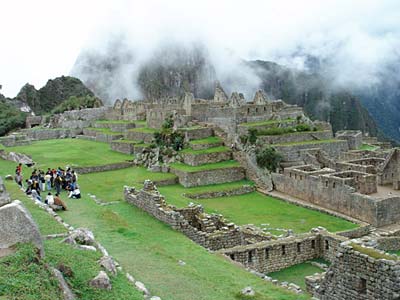
The 20-minute bus ride from the town to the ruins of Machu Picchu is bumpy and harrowing. The river is turbulent after last night's torrential rain.
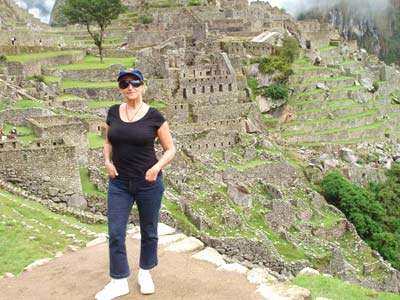
This is the beginning of the Amazon; we protect our skin with mosquito repellent. The ruins take my breath away as my eyes adjust to the city of 214 buildings once inhabited by 500 Incas and sweeping views of the majestic Andes shrouded in mist. Hiram Bingham, a professor at Yale, discovered Machu Picchu in 1911; he divided it into two sections, urban and agricultural, and then determined what complexes of buildings would be used for artisan, industrial and religious purposes. The stone steps are uneven and steep' there are many' it is not easy walking up and down, from plateau to plateau.
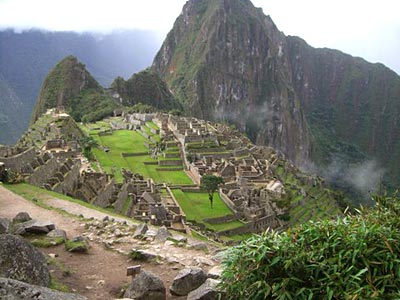
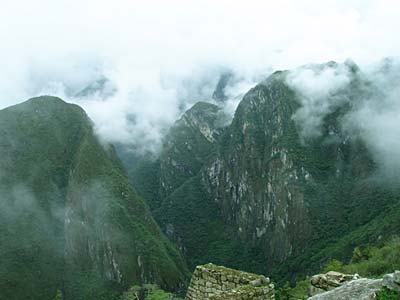
We rest at the Royal Tomb where an exceptionally beautiful male mummy was discovered. One third of Machu Picchu has been rebuilt, but the 'Inca Wife Building', named for the female objects Bingham found under the ground, is 100% original; niches in the walls suggest they were used for objects.
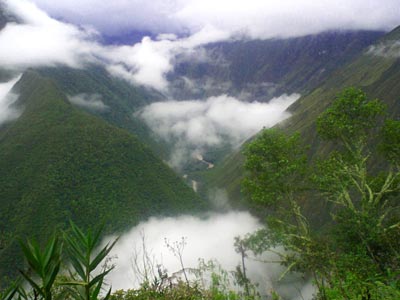
The Incas were a healthy and lean race, short in stature with strong legs. They ate natural organic foods from the fields and rivers; they ran from town to town, always sweating, never victims of heart disease. By age 25, Inca women had nine to 10 babies, receiving farm land for each birth. There are many theories as to why the Incas abandoned Machu Picchu while it was still under construction. Was it a plague, an earthquake or the wrath of the Gods they worshipped? We may never know, but the mystical powers of the Incas are gripping. As we slowly descend, it begins to rain, washing away my footprints, preparing and purifying this sacred ground for those who will follow.
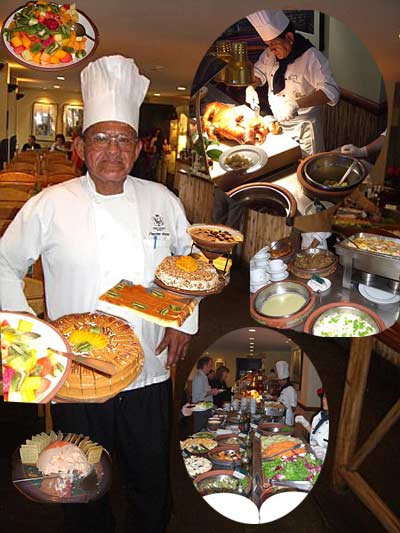
The buffet lunch at the Sanctuary Hotel is a delicious treat. The selection of traditional Peruvian dishes are exceptional: steamed potatoes with Huacatay, cheese and peanut sauce, trout in Parisienne sauce, Ceviche compress salad, green fava bean salad made with corn, onions, chopped tomatoes and cheese, rice salad with tuna, whole pig with apple sauce, stuffed chicken with hot chili sauce and a variety of vegetables, pastas and lentils. On the train ride back to Cusco, we are treated to entertainment and a fashion show of colorful women and men's sweaters knitted with wool from local llamas and vicunas.
Hotel Monasterio in Cusco, once a convent for monks and nuns, is a gem in the Orient Express collection of exceptional properties. Two hundred original 16th century paintings and sculptures adorn the rooms; guests awake to Gregorian chants in one of three courtyards and Thursday mass in one of three chapels. Marco Alban, the Executive Chef, and I sink into deep couches in the hotel's bar. We share an excellent Argentinean red wine, sample an assortment of Peruvian delicacies and chat about his connection to the farmers. 'I do not want to change them; I want to learn from them.' He says.
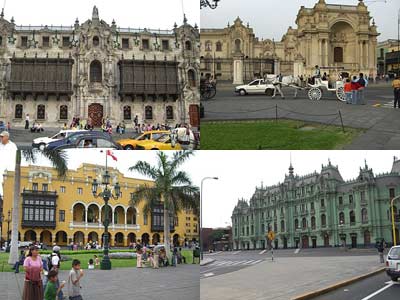
We spend our last day touring Lima, the city of balconies, colonial buildings, beautiful squares and La Huaca Bucellana, a buried Inca city in the middle of town. We dine at Rosa Nautica, one of the city's best seafood restaurants, and then head to the airport for the long flight back to reality.